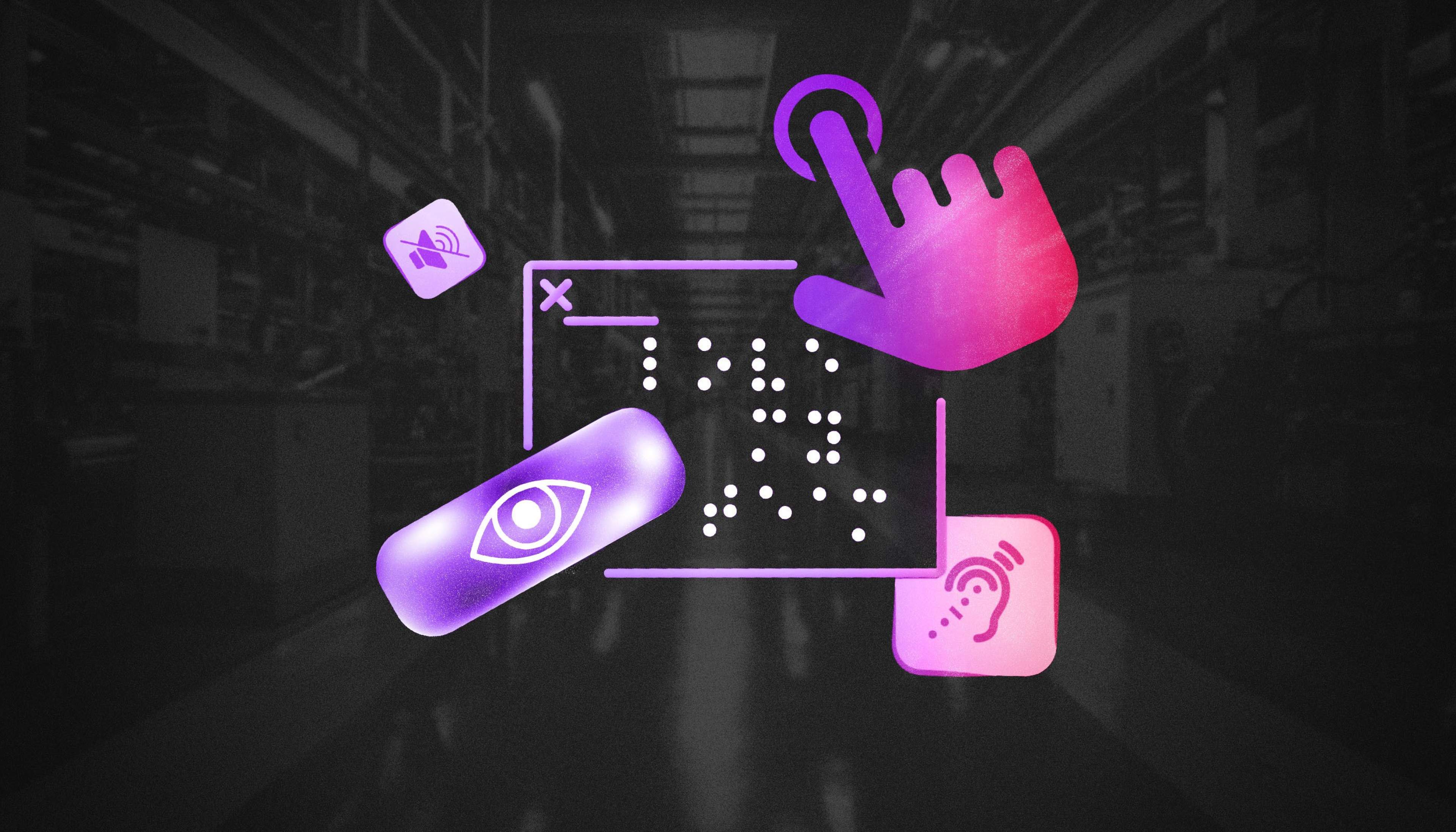When businesses discuss accessibility, it's often framed as an edge case affecting a minority of users. Consider visual impairments: 8% of Americans experience them—a significant number, but not a majority. When teams evaluate implementation costs against perceived benefit, these users can be overlooked. However, accessibility encompasses more than commonly recognized.
Accessibility benefits everyone. Beyond permanent disabilities (like being born blind), we must consider temporary disabilities (like recovering from eye surgery) and situational disabilities (like focusing only on the road while driving)—circumstances we all encounter. These are known as situational impairments or situational limitations: brief, often unexpected contexts where a person’s ability to interact with a system is reduced. Protective gloves, a loud factory, or even bright sunlight can dramatically change how we interact with digital experiences.
This broader perspective reveals accessibility's true scope. We're not designing with accessibility in mind solely to benefit the 8% with permanent visual impairments, but also for those with temporary eye conditions and drivers watching the road. By acknowledging the full range of types of disabilities—permanent, temporary, and situational—we shift from compliance to inclusive design.
A 2020 Accenture study demonstrates that businesses practicing disability inclusion unsurprisingly achieve 28% higher revenue, double the net income, and 30% higher profit margins than their counterparts—who exclude significant portions of the population. This demonstrates that building accessible products and experiences benefits businesses as well as all users, with and without current disability.
People with disabilities, whether they rely on assistive technologies like screen readers or require better color contrast and keyboard navigation, also benefit from environments shaped by thoughtful accessibility features and usability best practices. Consider curb cuts, introduced in 1945 for disabled veterans. These modifications subsequently benefited parents with strollers, cyclists, and pedestrians—creating universal improvements through accessible design. The same logic applies to the digital realm: by following WCAG and ADA standards—like including alt text, ensuring functionality across devices, and meeting Web Content Accessibility Guidelines (WCAG 2.1)—we reduce accessibility barriers for everyone.
This principle is particularly relevant in manufacturing environments. These are six common use cases I've seen where accessible design supports every day users:
Vision Impairment — Restricted Vision Due to Working Outside in the Sun In a recent project, I discovered employees preferred dark mode interfaces contrary to my initial light aesthetic designs. Upon investigation, this preference stemmed from practical necessity—most workers operated outdoors where bright sunlight significantly reduced visibility. Dark mode improved screen legibility, demonstrating how environmental conditions create situational impairments akin to visual impairments, impacting how interfaces are perceived. Even a glance at a mobile phone becomes a struggle when sun glare creates unanticipated accessibility issues
Hearing Impairment — Obstructed Hearing Due to Working in a Loud Environment with Heavy Machinery, Often Wearing Ear Protection During a client site visit, communication proved challenging amid the machinery noise, compounded by mandatory ear protection. I found myself completely dependent on lip reading—when someone's face wasn't visible, comprehension became impossible. This environment creates a universal hearing loss scenario. It reminded me of how an ear infection can simulate the same auditory challenge, reinforcing how even those without permanent impairments encounter obstacles. In such cases, features like subtitles, notifications, or visual alerts—common in assistive technologies—can enhance the user experience for all.
Voice Impairment — Obstructed Speech Due to Working in a Loud Environment with Heavy Machinery The same noisy environment that hampered hearing also created voice-related accessibility needs. Even shouting could only reach those nearest to me, forcing us to rely on gestures for immediate communication and postpone substantive discussions until we returned outside. These conditions effectively silence all workers—no different from someone managing another communication challenge who benefits from digital accessibility design.
Motor Impairment — Reduced Mobility Due to Wearing Restrictive PPE, Especially Gloves Safety requirements create universal dexterity challenges. Required protective gloves significantly impede fine motor skills needed for touchscreen operation. While observing maintenance technicians, we noted a clear preference for laptops with keyboards over tablets—despite the bulk—as they enabled more effective interaction while wearing necessary safety equipment. These are classic situational disabilities that benefit from systems designed for keyboard navigation and voice control.
Cognitive Impairment — Distracted Focus Due to Multi-Tasking, Leaving a Task and Coming Back Though not unique to manufacturing, contextual interruptions are particularly prevalent in industrial settings, especially in understaffed operations. Senior employees frequently transition between multiple responsibilities, requiring interfaces that preserve context and support easy resumption. These moments create cognitive impairments and highlight the value of design principles that prioritize memory aids, minimized distractions, and chunked task flows. Well-designed digital products can bridge these gaps and prevent accessibility barriers before they occur.
Motor Impairment — Limited Use of Hands Due to Work-Related Tasks Beyond PPE restrictions, the fundamental nature of industrial work demands near-constant hand use. Employees continuously juggle tools, equipment and documentation responsibilities, resulting in situational limitations. We observed workers constantly shifting items between hands and temporarily placing tools on surfaces to document their work before quickly retrieving them. In these moments, inclusive design might include voice notes, one-handed app modes, or wearable inputs — accessibility features that support people with disabilities and, in manufacturing environments, benefit the majority of users at one time or another.
These six examples illustrate how situational disabilities permeate industrial environments, affecting the majority of workers using the tools we design. They demonstrate that accessibility extends far beyond specialized accommodations for a minority—it addresses universal usability challenges.
Accessibility isn't merely a compliance checkbox to avoid litigation under the Americans with Disabilities Act (ADA), though that remains a valid consideration. As we design for what initially appear to be edge cases, it becomes evident that most employees in manufacturing and industrial settings experience some form of situational impairment during their workday. By recognizing and accommodating these limitations, we create solutions that enable all employees to perform their jobs more efficiently, safely, and effectively.




